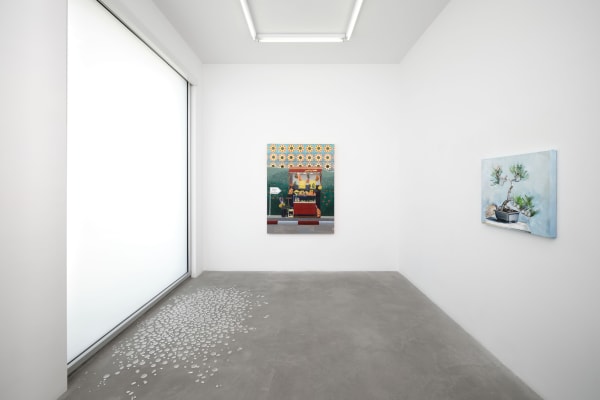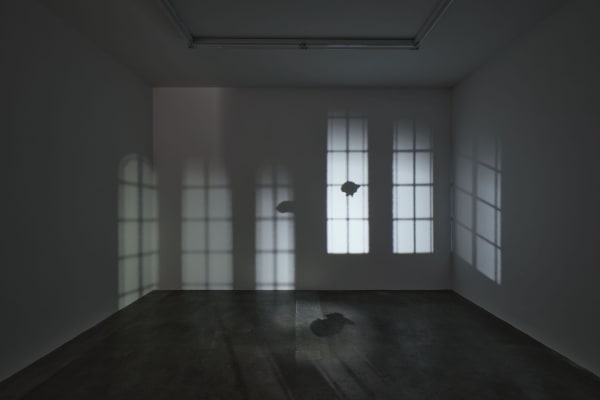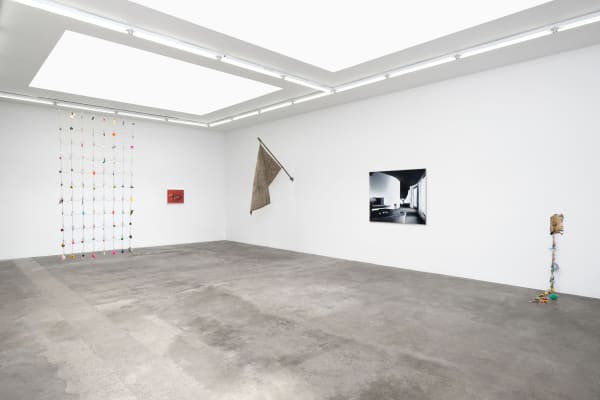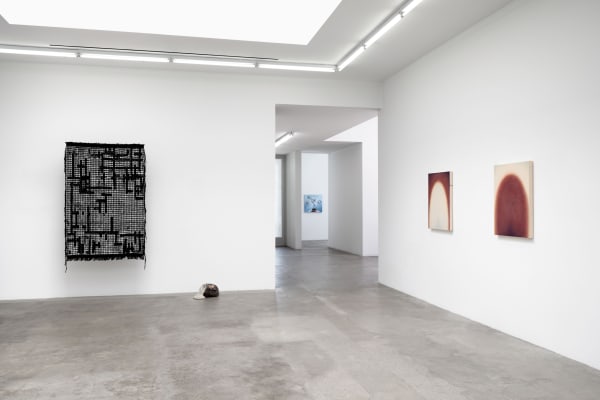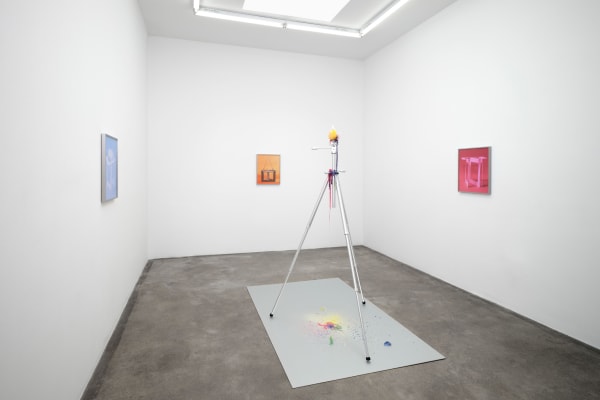Signal Fires: Tanya Bonakdar Gallery, Los Angeles
Tanya Brodsky
Eduardo Consuegra
Yaron Michael Hakim
Saj Issa
Hilja Keading
Hings Lim
Muna Malik
Nobuhito Nishigawara
Hayley Quentin
Sarah Rosalena
Lenard Smith
Claudia V. Solórzano
Tanya Bonakdar Gallery is pleased to present Signal Fires, a group exhibition which brings together twelve artists with ties to Southern California, all of whom are negotiating concepts of communication across vast distances: conceptually, formally, spiritually, and geographically.
In both recorded and fictional history, the act of lighting signal fires or beacons on high mountains to alert and relay urgent transmissions across spatial expanses is a story of language and how it can operate outside of the alphabetic or textual. This poetic, primeval telecommunication system requires pre-formed plans and communal understanding of the signal’s intention. Signal fires were precursors to heliographs, semaphore flags, lighthouse beacons, and Morse code. While the relationship of geographical location and relay of message are a thread that ties the works together, it’s the title words (signal and fires) which can playfully run into one another, becoming signifier, a slurred understudy of the central theme.
Approaching their processes of creation through the lenses of temporal and geographic language, the artists in the exhibition signal both to the past and towards an unrealized future. They are speaking strongly to concepts of duality: identity and heritage, technology and spirit, mythologies and personal narratives. Ultimately, it’s the signs and symbols of visual language that hold significant weight.
Tanya Brodsky was born in Kyiv, Ukraine and lives and works in Los Angeles. Two works in the exhibition display sourced keychains as markers of identity. In Deadbolt, a cast bronze door’s lock and key hold an extended daisy chain of keychain flare that spills onto the floor. These tchotchkes, or various markers of personality, become something like a timeline - its additions leaving us wondering about the connections we have to these small, everyday objects. In the larger hanging grid work, Other People 2, each chosen keychain has its own spacing, marking symbolism and possible hierarchies of the trinkets. Each one is a seemingly special, yet mass produced object.
Born in Bogota, Colombia, Eduardo Consuegra creates paintings and collages that use the modernist languages of historical architectural and design periodicals to discuss space and temporality. Drawn from specific historical printed matter, the work Untitled (casa Calderon, [Fernando Martinez Sanabria], 1963 explores ideas of re-presentation, developmentalism and power dynamics between North and South America, asking various questions about the dreams and subsequent failure of revolutionary practices during a post- war, mid-century era, and thus subsequently influencing Consuegra’s own history and practice.
As a transnational, transracial adoptee, Yaron Michael Hakim spent his early life on three different continents. His work depicts the recontextualization of flora and imagined fauna as ways to examine his heritages. Painted on reclaimed sailcloth, Higo/Sabra depicts a doubled, prickly pear cactus, a plant endemic to some geographies, but ultimately is borderless. Hakim is interested in how a plant can become symbol of cultural identity across territories, being adopted as a signifier for different things. No Dar Papaya depicts the titular fruit sliced open, its seeds spilling out, over a Colombian mountain landscape. The saying literally translates to “Do not give Papaya,” which is a caution to not make oneself vulnerable to others. Hakim thinks of this painting as a portrait of his unknown biological mother whom he has never met and whose name he doesn’t know.
Saj Issa received her MFA at UCLA in 2023 and now divides her time between St. Louis and with her family in Palestine. Her work addresses notions of displacement, identity, protest, and the ongoing conflicts of living in two separate realities. The multimedia work in the exhibition They’ve Changed the Signs 2, combines geometrically fading ceramic tiles with a painted scene of a fruit and vegetable stand next to a sign pointing towards Jerusalem. The beautifully rendered, daydream-like poppy landscape behind the stand seems to break with the tiled wall and fade into the unknown background.
Hilja Keading, an artist who is known primarily for her multi-channel video and sculptural installations in Los Angeles for the past 30 years, has created a new series of paintings which document and describe the practice of bonsai tree trimming. These works are a departure from her previous mediums, but still maintain her focus on working in and with forms of nature and consciousness. She came into temporary stewardship of over 60 bonsai through a death in her family and began to photograph, measure, and paint the bonsai, to scale. Her interest in the bonsai trees lies in their lineage and the shape-shifting forms by their owners, whom the plants themselves will outlive.
Born in Kuala Lumpur, artist Hings Lim’s practice expands on technology, both new and historic, involving participatory installation and experimentation with new and fascinating materials. Homo Lanterns, a video installation, activates another viewing of the passage of time. Several light projections of windows follow the space of the room. Inside of these projections is a somewhat inscrutable image, that of a hominin skull from 7 million years ago floating inside of the windows of light. Another work, Flaming Tower, relies upon ongoing transformation and participation. For the duration of the exhibition, wax-cast and digitally replicated Biface candles will be lit upon a tripod tower. The Biface, a stone tool (like a spear or knife) is a symbol of ancient innovation. The candles are ceremoniously replaced daily, allowing consideration of the human experience of time.
A 2024 graduate of the USC Roski MFA program and multidisciplinary artist based in Los Angeles, Muna Malik was born in Sanaa, Yemen. Her work uses abstract forms and gestures to explore history and identity influenced by Arabic and Somali concepts, forced movements, and migrations. Her work on view, New Immigrant Portrait, is an extraordinary sculpture that raises the questions of flags as signs, signals and symbols, even when their identity has been obscured and changed by acrylic, plaster, concrete and hand-drawn, alternate imagery.
Drawing from the immigrant experience of his early childhood, Nobuhito Nishigawara has created an ongoing series of ceramic and rock works, titled Qualia, a philosophical term concerning the subjective subconscious experience, which explores the dual cultural forces that have shaped his relationship to identity. Moving from Japan to North America to attend school at an early age, he recalls suppressing emotions to assimilate. With the found rocks, Nishigawara creates a playful new form of expression from which the natural materials ooze and drip, suggesting acceptance through the joining of two different materials and two different worlds.
Based in Los Angeles, Hayley Quentin creates works with watercolors and colored pencil on canvas that reverberate around simple, yet deep themes of mysticism, human identity and ethereal duality. The paintings are singular, but also are positioned and reflected off one another, forming questions about what is knowable. Senex and Puer are named for archetypal concepts which represent opposing temporal psyches and depict an inverse of one another. Stranger and Pursuant are extensions of these ideas. Each shows a pendulum: a droplet plunging to earth, or a uvula suspended over an expectant tongue; an almost contrary expression of natural forces.
Sarah Rosalena (Wixárika) is a Los Angeles-based interdisciplinary artist working between handicraft traditions and emerging technologies in textiles, beadwork, and clay. Her works blur the edges between high and low tech, human and nonhuman, the ancient and the future, and tradition and progress beyond power structures rooted in colonialism. Hanging from the ceiling, Exit Grid Paper depicts a computerized grid weaving, made from paper and cotton yarn which creates a glitched tapestry with an unresolved and borderless edge. This work draws on the material of early computing, and the errors that exist in technologies of today.
Lenard Smith, a first generation Ghanian-American artist, creates photographs that blend notions of sculpture and still-life photography. Repurposing matte boards from prints made when he was a teenager, Smith constructs arrangements for three brightly colored photographs. These images offer a fresh vernacular developed by the artist; symbols that are representative of and play with what we already know about the formal structure of buildings. Continuing a theme of disassembly and repair, All of Us, one part of a different series from 2020, depicts a broken duck ceramic figurine, positioned close together but not fully mended.
Los Angeles-based artist Claudia V. Solórzano works primarily in ceramics, addressing ephemerality of communities confronted with gentrification in the Greater Los Angeles area. Her sculptures preserve the unifying aesthetic of the urban terrain, drawing inspiration from her family home and the city's architectural motifs, such as wrought iron structures and window bars. These forms provide a sense of protection and act as portals to an atemporal reimagined territory, blending reality with visionary possibilities.
This exhibition was curated by Los Angeles Director, Lia Trinka-Browner
Photo by Paul Salveson
